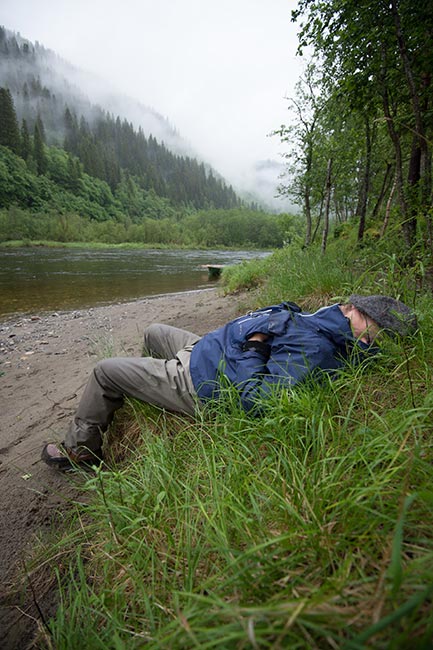The bank of the Gaula River made a very comfortable recliner during the long fishing days in Norway.
Photos by Sandy Hays
Most anglers consider themselves above the petty squabbles that so often erupt in the fly-fishing community, content to let other anglers define the boundaries of the sport for themselves. (Today’s topic: Is a pegged bead really a fly? Yawn.) However, it’s been my experience that there’s one group of anglers who don’t benefit from such leeway—your own fishing buddies.
Whereas you might not bat an eye at a strange angler chucking a Woolly Bugger during a perfectly good Hendrickson hatch, should one of your own group try such a thing, the merciless taunting begins immediately. It’s not that you actually object to his tactic (it works, after all); it’s just that now you have a high horse from which you can browbeat your pal for sport. Two time-honored techniques for such abuse include mock indignation (“How dare you?”) and mock disappointment (“We never knew you were that kind of guy”).
For several years early in my fly-fishing career, I spent two long weekends per season on Maine’s Rapid River in the company of my high-school friends, Fred and Sandy Hays—a.k.a. the Wretched Hays Boys. Because we were young men, there was of course a certain amount of angling competition, and there was also enough good-natured ribbing to go around. That we all had very different angling styles and philosophies meant that there was plenty of fodder for the ridicule mill.
Fred has seemingly endless patience, willing to cast to the same spot fifty times before moving on, and in those days, he used no more than half a dozen different patterns. Sandy had a more laissez-faire approach, often tying on the most bizarre fly in his vest, just to see if it might scare a trout or landlocked salmon into biting. (As a joke, I once gave him a fly I called the Depth Charge, which was a Conehead Woolly Bugger tied on a saltwater hook, with a rubber Mister Twister tail attached at the bend; he caught a 16-inch brookie on it about ten minutes later.) I was the group geek, trying to apply all the lessons I’d learned from books and magazines and intent on matching any bugs that were hatching or could be found under the rocks.

The beach on the Moy Estuary in Ireland made a fine napping spot when the seatrout weren’t biting.
But there was one point on which Sandy and I were united in our mockery of Fred: When the fishing was slow, Fred would often reel up, find a comfortable spot, and go to sleep. To Sandy and me, this was nothing more than a cop-out—we were there to fish, man!—and we accused him of sulking and being a baby who couldn’t take it when things got tough. Fred would just smirk, cover his eyes with his hat, and zonk out. Sandy and I would continue fishing, badmouthing the slumbering beast the whole time.
All these years later, however, I have come to realize that Fred had it right all along. Call it the result of wisdom or physical decline, but I no longer feel the burning desire to spend every second of every angling day trying to catch more fish. The joys of the on-the-water nap are manifold—the sound of rushing water or waves, the warm sun, getting out of the wind, and so on—and it leaves you refreshed for the better fishing that’s bound to occur later in the day. I’ve slept in driftboats, on beaches, and in an alder thicket, among many other fishy spots, and I don’t feel like I’m missing any fish.
A couple years ago, when I was salmon fishing in Norway, we were often on the water for more than twelve hours in a day. Since fishing for Atlantic salmon requires endless casting, with low success rates, the sport is custom-made for the on-stream nap. At least once a day, I would hand my rod to our guide, Alessio, and say, “Why don’t you fish for a while.” Then it was time to lie down and let the mind wander. And you know what? Alessio never hooked a fish while I slept.
Credit: Source link































